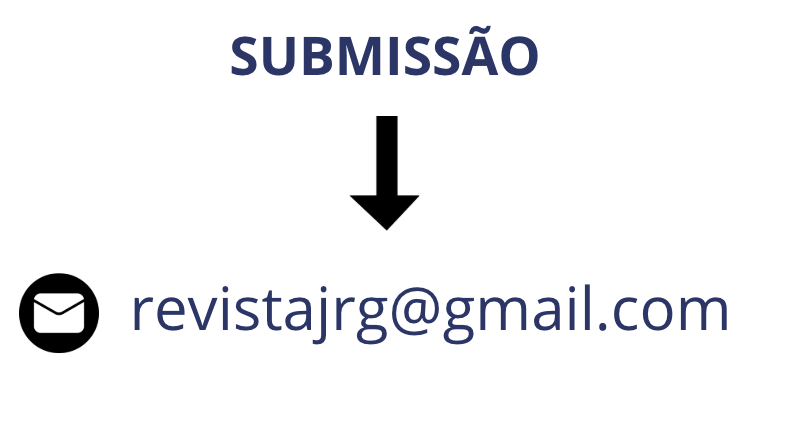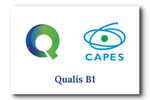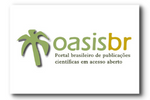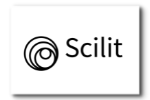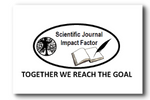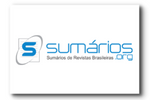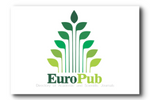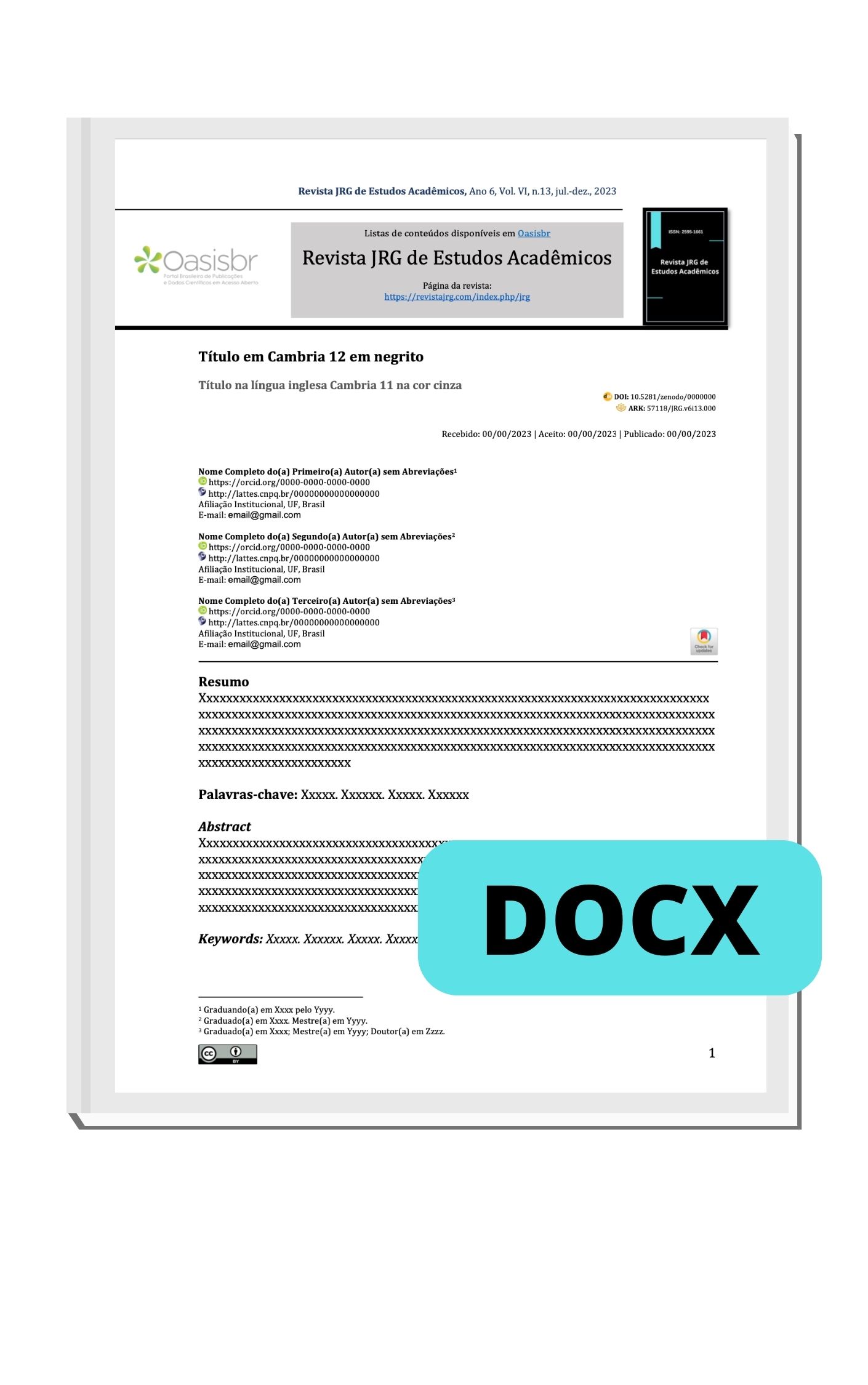Variability of temperature, rainfall and reference evaporation of catolé do Rocha-PB municipality, semi-arid region of Brazil
DOI:
https://doi.org/10.55892/jrg.v7i14.578Palavras-chave:
Climate change, Evapotranspiration, Semiarid regionResumo
The state of Paraíba, specifically in the alto sertão of Paraíba, is characterized by the spatial and temporal variability of rainfall, of temperature and evapotranspiration, coming from the semi-arid climate that is inserted in the region, and yet, the performance of different meteorological systems. The objective was to quantify the rainfall, temperature and reference evaporation (mm/ month and mm/year) comprised in the experimental period between 2016 to 2020, in the municipality of Catolé do Rocha-PB, in order to determine the history of the rainy and dry season, and thus, minimize agricultural production losses due to environmental factors. The daily rainfall, temperature and reference evaporation data were obtained by means of a rain gauge and the indirect method of the class A tank, respectively. The rainfall (mm year-1) was analyzed by the nonparametric Friedman test, the Conover test and reference evaporation (mm year-1) applied the parametric test of the ANAVA and the test of Tukey HSD. Both parametric and non-parametric tests were analyzed by Real Statistics. Temperature data was compiled from the website (www.inmet.gov.br) in order to control, statically collecting and decision-making in the process of building scientific knowledge regarding meteorological data (climate - Temperature). Were also analyzed pearson's correlation matrices and elementary principal components analysis for the rainfall variables, Eto and Temperature in the studied experimental period. Were also studied the principal component analysis between the years 2016 to 2020 and its significance by the t test. The average reference evaporation between 2016 and 2020 was 2.1 times greater than rainfall. Mean rainfall and reference evaporation in Catolé do Rocha-PB between 2016 and 2020 were 827 mm ano-1 and 1704 mm year-1 and are compatible with historical averages of 800 mm year-1 and 1700 mm year-1, respectively. Inglesa.
Downloads
Referências
Agência Nacional de Águas – Ana (2009) Fatos e tendências: água. Ana, Brasília. 36.https://arquivos.ana.gov.br/institucional/sge/CEDOC/Catalogo/2006/AguaFatosETendencias.pdf
Ahmad, T., Aadil, R. M., Ahmed, H., ur Rahman, U., Soares, B. C. V., Souza, S. L. Q, et al. (2019) Treatment and utilization of dairy industrial waste: A review. Trends in Food Science & Technology, 88, 361-372. https://doi.org/10.1016/j.tifs.2019.04.003
Alvares, C. A., Stape, J. L., Sentelhas, P. C., Gonçalves, J. L. M., & Sparovek, G. (2014) Köppen's climate classification map for Brazil. Meteorologische Zeitschrift, 22(6), 711-728. DOI: 10.1127/0941-2948/2013/0507
Arenas-Sánchez, A., Rico, A., & Vighi, M. (2016) Effects of water scarcity and chemical pollution in aquatic ecosystems: State of the art. Science of the Total Environment, 572, 390-403. https://doi.org/10.1016/j.scitotenv.2016.07.211
Carvalho, A. T. F. (2020) Caracterização climática da quadra chuvosa em apodi, semiárido brasileiro, nos anos de 2013 a 2017. Revista Geografia em Atos, Departamento de Geografia, Faculdade de Ciências e Tecnologia, UNESP, Presidente Prudente, n. 17, v. 2, p. 4-23, abr/2020.
Coelho, D. C. L., Batista, R. O., Silva, P. C. M., & Mesquita, F. O. (2015) Produção de capim elefante utilizando percolado de aterro sanitário. Bioscience Journal, 31(3), 830-840, 2015. DOI: https://doi.org/10.14393/BJ-v31n3a2015-22400
Demirel, B., Yenigun, O., & Onay, T. T. (2005) Anaerobic treatment of dairy wastewaters: a review. Process Biochemistry, 40: p.2583-2595. https://doi.org/10.1016/j.procbio.2004.12.015
Environmental Protection Agency - Epa (1981) Process design manual: land treatment of municipal wastewater. Department of the interior, Washington. 625. https://www.epa.gov/aboutepa/about-national-risk-management-research-laboratory-nrmrl
Farizoglu, B., & Uzuner, S. (2011) The investigation of dairy industry wastewater treatment in a biological high performance membrane system. Biochemical Engineering Journal, 57, 46-54. https://doi.org/10.1016/j.bej.2011.08.007
Ferreira, D. F. (2011) Sisvar: a computer statistical analysis system. Ciência e Agrotecnologia, 35(6),1039-1042. https://doi.org/10.1590/S1413-70542011000600001
Food and Agriculture Organization of the United Nations – Fao (2016) AQUASTAT website. Website accessed on [2020/01/06]. http://www.fao.org/news/archive/news-by-date/2016/pt/
Hawke, R. M., & Summers, S. A. (2006) Effects of land application of farm dairy effluent on soil properties: a literature review. New Zealand Journal of Agricultural Research, 49(3), 307-320. DOI: 10.1080/00288233.2006.9513721
Lima, V. I. A., Alvez, S. M. C., Oliveira, J. F., Batista, R. O., Pinheiro, J. G., & Di Souza, L. (2013) Desempenho do sistema de tratamento de água residuária de laticínios e os efeitos de sua disposição em Argissolo. Water Resources and Irrigation Management, 2(2), 93-101. https://www3.ufrb.edu.br/seer/index.php/wrim/article/view/1613
Lopes, J. R. A., Bezerra, J. M., Almeida, N. M. D., Gonçalves, G. L., Mendonça, S. S. C. (2020). Águas subterrâneas como alternativa de subsistência em uma comunidade rural no semiárido brasileiro. Estudos de Caso e Notas Técnicas, v. 1, n. 1, p. 1-6, 2020.
Liu, J., Liu, Q., & Yang, H. (2016) Assessing water scarcity by simultaneously considering environmental flow requirements, water quantity, and water quality. Ecological Indicators, 60, 434-441. https://doi.org/10.1016/j.ecolind.2015.07.019
Marques, B. C. D., Cunha, V. T., Cunha, V. T., Silva, K. B, & Batista, R. O. (2016) Desempenho de gotejadores operando com água residuária de laticínios em escala laboratorial. Irriga, 21(1), 140-155. DOI:10.15809/IRRIGA.2016V21N1P140-155
Messias, A. S., Távora, B. E., Silva, R. C. R., & Nascimento, A. E. (2006) Percolação de sódio através de solos do Estado de Pernambuco, Brasil. Revista de Biologia e Ciências da Terra, 2(1), 65-72. http://joaootavio.com.br/bioterra/workspace/uploads/artigos/ percolacaope-51818cfa62ef6.pdf
New South Wales Government – NSW (2010). Effluent reuse management: Strategic environmental compliance and performance review. Department of Environment and Climate Change and Water, Sydney. 64. https://www.epa.nsw.gov.au/-/media/epa/corporate-site/resources/licensing/10824effluentreusereport.pdf
Oliveira, J. F., Alves, S. M. C., Batista, R. O., Lima, V. I., & Di Souza, L. (2014) Avaliação de sistema de tratamento de laticínio e o efeito do efluente gerado nos atributos físico-químico de um argissolo vermelho. Engenharia na Agricultura, 22(1), 58-66. DOI: 10.13083/1414-3984.v22n01a07
Oliveira, A. M. P., Rebouças, C. A. M., Dias, N. S., Portela, J. C., & Diniz, A. A. (2016). Contamination potential of specific ions in soil treated with reject brine from desalination plants. Revista Caatinga, 29(3), 569-577. https://doi.org/10.1590/1983-21252016v29n306rc
Oliveira, A. M. P., Rebouças, C. A. M., Dias, N. S., Souza Júnior, F. S., SÁ, F. V. S., Sousa Neto, O. N. et al. (2017) Dynamics of ions in soils irrigated with saline reject. Journal of Agricultural Science, 9 (11), 190-197. DOI:10.5539/jas.v9n11p190
Pereira, M. S., Borges, A. C., Heleno, F. F., Squillace, L. F. A., & Faroni, L. R. D (2018). Treatment of synthetic milk industry wastewater using batch dissolved air flotation. Journal of Cleaner Production, 189, 729-737. https://doi.org/10.1016/j. jclepro.2018.04.065
Qasim, W., & Mane, A. V. (2013) Characterization and treatment of selected food industrial effluents by coagulation and adsorption techniques. Water Resources And Industry, 4,1-12. https://doi.org/10.1016/j.wri.2013.09.005
Rezapour, S., Samadi, A., & Khodaverdiloo, H. (2012) Impact of long-term wastewater irrigation on variability of soil attributes along a landscape in semi-arid region of Iran. Environmental Earth Sciences, 67 (6), 1713-1723. DOI: 10.1007/s12665-012-1615-1
Ribeiro, A. C., Guimarães, P. T. G., & Alvarez, V. H. (1999) Recomendações para o uso de corretivos e fertilizantes em Minas Gerais. Comissão de Fertilidade do Solo do Estado de Minas Gerais, Viçosa. 322. http://anda.org.br/wp-content/uploads/2018/10/boletim_04.pdf
Santos, H. G., Jacomine, P. K. T., Anjos, L. H. C., Oliveira, V. A., Lumbreras, J. F., Coelho, M. R., et al. (2018) Sistema brasileiro de classificação de solos. 5. ed. rev. e ampl. Embrapa, Brasília. 5:356. https://www.editoraufv.com.br/produto/sistema-brasileiro-de-classificacao-de-solos-5-edicao/1110814
Teixeira, P. C., Donagemma, G. K., Wenceslau, A. F., & Teixeira, G. (2017) Manual de métodos de análise de solo. 3.ed. Embrapa Solos, Rio de Janeiro. 573. http://www.infoteca.cnptia.embrapa.br/infoteca/handle/doc/1085209
Toze, S. (2006) Reuse of effluent water - benefits and risks. Agricultural Water Management, 80 (1-3),147-159. https://doi.org/10.1016/j.agwat.2005.07.010.
Downloads
Publicado
Como Citar
Edição
Seção
ARK
Licença

Este trabalho está licenciado sob uma licença Creative Commons Attribution 4.0 International License.



